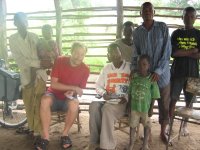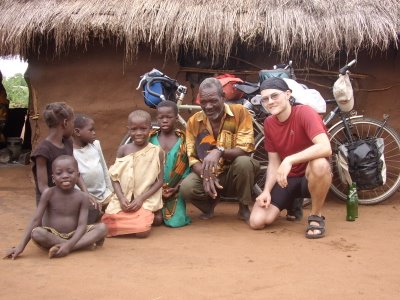Africa vs. USA: Cycling Challenges
For those who have never read my posts (does anyone read these?): In 2006, I spent nearly six months traveling by bicycle with a friend through seven countries of Southeast and East Africa. Our journey began in Beira, Mozambique, and followed Africa’s Great Rift Valley northwards to Nairobi, Kenya. The distance covered was 2,100 miles by bicycle and 1,200 by bus and boat. One year later, I returned to the bike saddle for a shorter, but more concentrated trip across the states of Nevada, Utah, and Arizona. That trip started near Carson City, Nevada, and ended in Tucson. It spanned seven weeks and over 1,500 miles, nearly all of which I cycled.
It may come as some surprise that, as a whole, traveling through Africa was no more difficult than traveling through this country. In fact, in many respects the challenges posed to me in Africa were less severe than those here at home. Of the myriad trials I faced on the road, most were related to three general elements common to travel anywhere: geography, logistics, and society.
For obvious reasons, the geography of an area has a profound effect on touring cyclists and their travel experiences. It can make a given trip seem consistently pleasant, easy, dull, and aimless, or consistently arduous, painful, and in the end, very rewarding. In Africa I passed through a great variety of ecosystems and terrains that included flat scrubland and savannah, hilly agricultural areas, and mountainous rainforest. We never traveled far without having to ascend a mountain, and some stretches of the road weaved through mountain ranges for days, but my overall impression of the trip is one of rolling hills. There was always plenty of easy riding between mountains to allow us to rest and prepare for the next grueling climb. In contrast, the terrain in the Western US followed a pattern throughout almost the entire length of the route: mountain, valley, mountain, valley. In the eight days that I spent crossing Nevada, I negotiated ten mountain passes. The remainder of the trip followed suit, and increased in physical difficulty all the way until the very last climb of the very last day.
In spite of the variety of ecosystems we encountered in Africa, the region’s tropical latitude provided for a surprisingly uniform climate throughout the trip: hot and sunny. Being a native of the desert, I found the heat relatively unbothersome and greatly preferable to a cold climate. In this country, the weather presented an even greater challenge than the terrain. First, there was the problem of my poor preparation; I incorrectly assumed that traveling through the desert at the end of spring and beginning of summer would be a warm and sunny affair, much as it was in Africa. On the contrary, the nighttime temperature was regularly in the 30’s for the first few weeks (a significant discomfort when camping with cheap summer gear), and on several of my daytime rides I was beset by rain, hail, and snow. My dogged insistence that “the warm weather will come tomorrow” prolonged the suffering for weeks.
The most important logistics to consider on a cycling tour are the availability of supplies, especially food and water, and the roads that will be traveled on. One of the most common questions people ask me about my trip in Africa is, “What did you do for food and water?” The perception of Africa that persists among Westerners, that of a dusty and fruitless desert, is a product of our highly selective media coverage and is far from the truth. It is true that there are huge expanses of desert on the continent, but on the route that I followed, which would have spanned the USA from coast to coast, there was not one area of true desert. Food and water were easily available even in the most rural areas, where only the wealthy could afford to ride around on rickety bicycles imported from India. Community wells provided pure, refreshing groundwater and small family farms supplied the village with fresh produce, eggs, chicken, nuts, and beans. Granted, the diet was limited and came to be quite monotonous, but it was always fresh, gratifying, and cheap. On the unusual days when we didn’t pass through a village, we would get water from a stream or pond, and simply pack extra food. In the Great American Desert, on the other hand, I learned very early in my trip that I couldn’t afford to be haphazard in planning for provisions. On the second day of that tour, I arrived at a location marked on my map where I intended to refill my near-empty water bottles. The location turned out to be a locked up brothel. There were faucets in the compound, so I slipped through a gap in the gate to try them for water. They were dry. As I was leaving, a sheriff raced up to the brothel. I defused his initial anger and reasoned my way out of getting arrested, but I was told to leave the area immediately and that I would have to return to the last town to get water. Fortunately, on my way back to the town, two other cyclists coming my way told me of a truck stop 40 miles down the road with supplies. I barely had enough water to make it. I was unfamiliar with the concept of having to travel up to 120 miles between water and food sources. After that incident, I usually carried extra water, but the remainder of the trip was not without an occasional spell of thirst.
Although Africa certainly had a greater availability of sustenance, the roads were generally shoddy, and sometimes appalling. About one third of the roads we took in Africa were unpaved, which equates to 700 miles. Many of those roads were rocky or sandy tracks, which made short work of our bicycle chains, and our energy. The worst road of the trip, however, was the main highway linking Kampala, Uganda with Nairobi, Kenya. Incessant heavy traffic had torn the asphalt to pieces, leaving the highway without a shoulder and riddled with gaping potholes. After Africa, the roads here seemed smooth as butter. Only when I intentionally strayed from the pavement did I suffer a jolting ride. Aside from these more obvious physical challenges to overcome, there is another aspect of travel that can have a crucial impact on the traveler: society.
When I refer to society, I refer particularly to the people encountered along the way and the general disposition that prevails among them. To generalize for the sake of this essay, I will say that Africans are warm, friendly, and very helpful. Yes, there were exceptions; as my friend put it, every village has a jerk. Vendors consistently tried to overcharge us. However, to expect otherwise would be naïve. I was sometimes astounded by the generosity and hospitality that those usually poverty-stricken people extended to us. From the first day of the trip to the last, we were invited to stay in homes, offered the finest meals that could be offered, and regularly guided selflessly by local inhabitants. Africans are fully aware of the long and bloody history they share with the West. They know that white people have been a cause of their woes for generations. Yet, when confronted by two representatives of the West on bicycles, they chose not to be vindictive, but to express their cultural hospitality. Perhaps the most bothersome aspect of the society was the sheer number of the people. It was rare that we cycled for more than a few hours without passing through a populated area. Africans are very vocal and expressive people, and they found the sight of two white guys cycling through their villages very novel indeed, so we were constantly hailed, greeted, beckoned, and yelled at, though it was almost always done benevolently. In the States, I was again blessed with consistent hospitality and generosity from the people. Several people extended a helping hand along the road, whenever I needed it. I will always carry a fond memory of the man who, while I was soaked, covered in snow, suffering mild hypothermia, and enervated, plucked me out of the harsh Nevada elements and drove me to the next hotel several miles up the mountainous highway. However, the question I always carry in my mind is, “What if I were a black African cycling through the States? How would I be treated?” Although there are those who would disagree, claiming that “racism is dead,” I am certain that my experience would have been decidedly less agreeable.
I hope to have cast Africa in a somewhat more positive light than how it is usually seen. There is an element of fear associated with Africa, and I certainly was not immune to that at the outset of my journey. However, as I spent more time there, that fear was gradually replaced by an undying faith in the humanity of humanity. The fact of the matter is that every place and culture in the world has its advantages and disadvantages, with no one locality inherently better or worse than another. I had both positive and negative experiences on both trips. The overwhelming impression they share, however, is a positive one.









